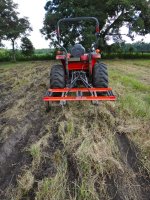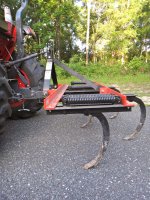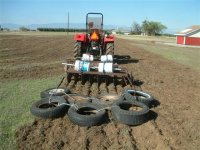jeff9366
Super Star Member
- Joined
- Jan 14, 2011
- Messages
- 12,787
- Tractor
- Kubota Tractor Loader L3560 HST+ ~~~~~~~~~~~~~ 3,700 pounds bare tractor, 5,400 pounds operating weight, 37 horsepower
Your weight calculation on each pan is useful calculating the setup. I believe added weight for my disc is limited by the less than robust construction of the implement? YES
Agreed, the front gang needs to do most of the cutting, leaving the rear gang to break up soil clods. Also proper adjustment of the top link is critical. I thought of slotting the top link bracket to allow some float when encountering uneven ground.
Any bounce due to a slot will create transient stress on the Top Link.
With a factory-heavy Disc Harrow there are times when you want the Top Link long, adding pressure to rear gangs, which draw soil inward. An example is drawing in soil from edges of a slightly sunk dirt road to even it. Filling random depressions in a field is another example.
The narrow front gang cuts and tosses soil outward.
The WIDER rear gang smoothes, collects and tosses soil inward.
Consider moving rear gangs outward on the box frame from current location. Outer U-bolts suspending gangs should be near ends of rear frame member, so rear gang width is wider than front. Lube on the frame and a rubber mallet aids the process.
Last edited:


